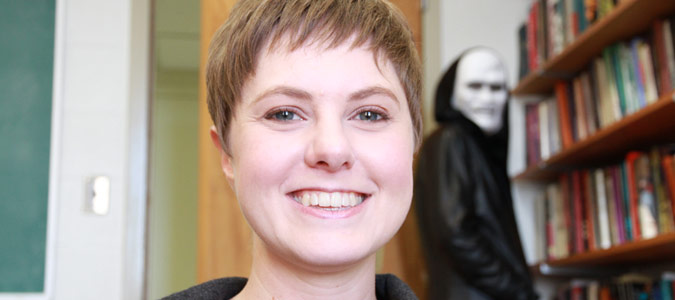The original X-files
From real-life ghost hunters to werewolves and teen vampire romances, contemporary pop culture is full of tales of the supernatural.
By Colleen MacPherson Society's fascination with vampires and things that go bump in the night is nothing new—it has existed for centuries. Lisa Smith explains that such tales grew out of the question of what happens to people when they die. An associate professor of history, Smith studies the history of medicine, pain and the body-soul connection.
Society's fascination with vampires and things that go bump in the night is nothing new—it has existed for centuries. Lisa Smith explains that such tales grew out of the question of what happens to people when they die. An associate professor of history, Smith studies the history of medicine, pain and the body-soul connection."When you look at a number of scholars from the late-17th and early-18th centuries, they are also very interested in these questions," she said.
Smith is in the early stages of researching what she calls 18th century X-files. Poring over scientific correspondence from the period, she finds accounts of scientists and doctors trying to make sense of the weird and unexplainable. Some of their attempts touch on the supernatural when medical science offers no clear explanation.
Her research thus far shows that the reasons for society's interest in the unexplained have changed. Today it is mainly entertainment but 18th-century scholars were concerned with answering an important question: is this a miracle or something natural?
"There's a big interest in teasing out what is supernatural, what is real, what is medical," Smith said.
Religious figures had a vested interest in proving the supernatural did exist, she said. In cases of people mysteriously rising from the dead, their concern was with determining whether someone had been miraculously resurrected or simply had not actually died. Scientists were similarly concerned with pinpointing what really happens to bodies after death.
Rather than being a source of entertainment and the occasional nightmare, the supernatural was something that posed a real threat, at least from a medical perspective, explained Smith. The vampires of yesteryear were not the glamorous, sexualized creatures of pop culture; rumours of vampirism were often related to some sort of outbreak.
For example, around 1731 on the Serbian border, a field surgeon oversaw the exhumations of a number of corpses after reports of a possible epidemic. Rumours of vampirism were also circulating. The surgeon's report showed that he saw things he did not expect to see in examining corpses and for which he had no scientific explanation. He even goes so far as to use the term "vampirism" in his report, though his reasons for doing so are not entirely clear.
"What surprised me most is how different the ideas of what we consider vampires are from the 17th- and 18th-century accounts. They don't necessarily bite and suck blood. Quite often they might go in and trouble people. There is lots of discussion of them sitting on people and suffocating them."
In some cases, rumours were as infectious as any tangible symptoms. "[People] talk about it as being an epidemic – perhaps not so much a physical epidemic as an epidemic of the imagination."
Smith's focus on eighteenth-century England and France is helping fill in some blank spots to complement research into witches and ghosts during earlier periods. She is looking into what happened to supernatural beliefs during the Enlightenment (about 1650-1789) and will be teaching a related undergraduate course in the winter term.
Lisa Buchanan is a graduate student intern in Research Communications

